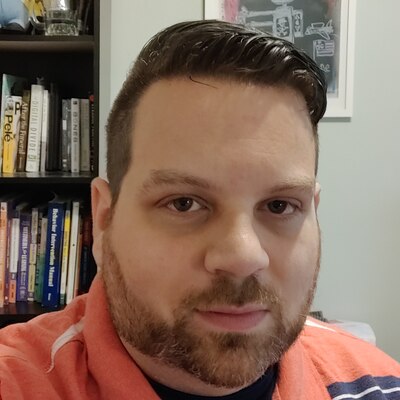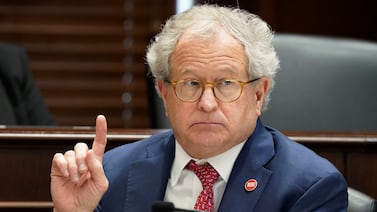When it comes to remote teaching, Brian Nagy had a head start.
By the time COVID-19 shuttered school buildings in March, Nagy — one of a handful of educators in New York City’s remote teaching pilot program — had been giving real-time lessons online for months. Beginning in the fall of 2019, the high school science and forensics teacher worked from an education department office in Queens, while his students logged on from their schools around the city. The goal of the experiment: to give students access to courses that their own high schools don’t offer.

Then came the pandemic, bringing online education to most of the city’s 75,000 teachers and its more than 1 million public school students. All told, students learned remotely for about a third of this past school year, and New York Mayor Bill de Blasio has said the fall will bring a hybrid of in-person and virtual learning to allow for social distancing.
Nagy, however, doesn’t see distance learning as a mere stop-gap measure until students can return to school five days a week. “I don’t think this cat goes back in the bag,” he said. “With a nationwide roll-out, were there struggles and stumbles? Sure. But I think remote learning can improve with real reflection and discussion about what worked and what didn’t.”
Nagy spoke recently with Chalkbeat about why remote learning suits some children, how he teaches students to analyze fingerprints (on Zoom), and why it’s important to seize opportunities — even when they seem improbable.
This interview has been lightly edited for length and clarity.
Since you’ve been teaching remotely for longer than most of your colleagues, what are some lessons you have learned in the course of this work?
I know that, especially with everyone being at home for the last few months, the availability of a device and having reliable connections, which even I struggled with, was challenging. But as one of my ed professors once said: “Good pedagogy is good pedagogy.” Lively discussion and developing connections with your students is important, and it’s totally achievable. The key is synchronous meetings. That allows you to show off your personality, to bounce ideas off of students in the moment, and to take those serendipitous answers that allow for deeper discussion of concepts and ideas. Later on [in the school year], when getting everyone together at once became a challenge, I started making sure my classes got to see my face and/or hear my voice regardless of when they signed in to work. I created lots of screen casts, demonstrations, and video lessons.
Other than that? I started keeping a list of assignments so my classes knew what to work on and in which order and that all of the assignments, reading, activities had links. There’s no better way to lose a student than to get them frustrated!
Now that most city teachers and students have tried it out, do you think remote learning is here to stay?
I don’t think this cat goes back in the bag. With a nationwide roll-out, were there struggles and stumbles? Sure. But I think remote learning can improve with real reflection and discussion about what worked and what didn’t.
Some students, for any number of reasons, really didn’t thrive learning from home, but I have more than a handful that did better than they did during in-person learning and that needs to be examined. Even though my content has always been available 24 hours a day, I think some students who have responsibilities at home or other distractions during the day learned that they can do the work even if it’s not at a prescribed time. One student, in particular, showed up to class one-third of the time when his school was open, but was there daily for over a month and then several times a week when everything was remote. He failed the first marking period of the term, but his grades reached the 80s by the end.
Why do you think remote learning suits some students?
It’s a lot easier to tailor assignments for students with certain settings, and since it’s specific to what each student sees, there’s no embarrassment. But you also had the kids who didn’t make it to school on time because they had to see their younger siblings to the bus or take care of other family members. Having content and work available at all times allowed students to work on their schedule and at their pace. It wasn’t about trying to get as much done in 45 minutes, but more about letting them really connect with the content and work at their speed.
What has been your favorite lesson to teach remotely — and what about it works well?
I think the one I enjoyed the most was when we were learning about fingerprints. Zoom has a great feature called Annotations. It allows me and the students to write over a shared screen. Students were given a reference sheet of different fingerprint patterns and I shared an enlarged image of a fingerprint. I started by calling out a few of the patterns — called minutiae — and asking students to find an example on the print, which they’d circle from their own computers. Then they used pencils and tape to take their own prints, which they took pictures of and we repeated the procedure with their own prints, which made it more meaningful. They enjoyed it, and I fed off their energy.
Tell us about your own experience with school and how it impacts your work today.
I was a nerdy, geeky, loudmouth in high school. I think about how to keep someone like me from checking out and spinning on a lab stool in the back of the room. But I also think about what got everyone else in my classes interested.
I reflect on my instructors from middle school through college and there’s a lot of people to hold up as shining examples and a number of what-not-to-dos. But I always think back to Dr. Steve Brown, my Comparative Chordate Anatomy professor in college. I don’t even remember the lesson, but one day, he stopped after a really long, intense run of diagrams on the board and he looked at us, looked at the board, gave a top-line summary and just smiled and he said, “Isn’t that just so cool?” And it was. I learned two things in that moment: Even when the content is granular, take a moment to look at the big picture; and be passionate about what you’re teaching because if you’re bored, you better believe your class is too!
What’s the best advice you ever received — and how have you put it into action?
It’s cheesy, but “It can’t hurt to try.”
An email went out towards the end of the 2018-2019 school year asking for applicants for the new Remote Teacher Program. I bookmarked the email, but didn’t send everything in until the last day when I figured it couldn’t hurt to try. I wouldn’t be in the position I’m in now, enjoying my career, after a few tough years that really started taking their toll on me, if I didn’t bother sending in my resume and cover letter. I never would have picked up new tools and methods if I didn’t stop and say “how can this be better?” and then test it out.
I was trained in science. You’ll never know if a hypothesis pans out if you don’t test it. You’ll never learn to run if you don’t take the first few steps. I’ve learned to be brave enough to click around to figure out new tools, knowing I can fix a mistake with the back button.







